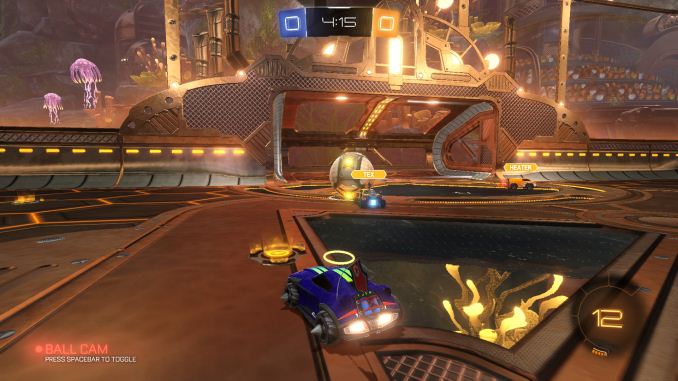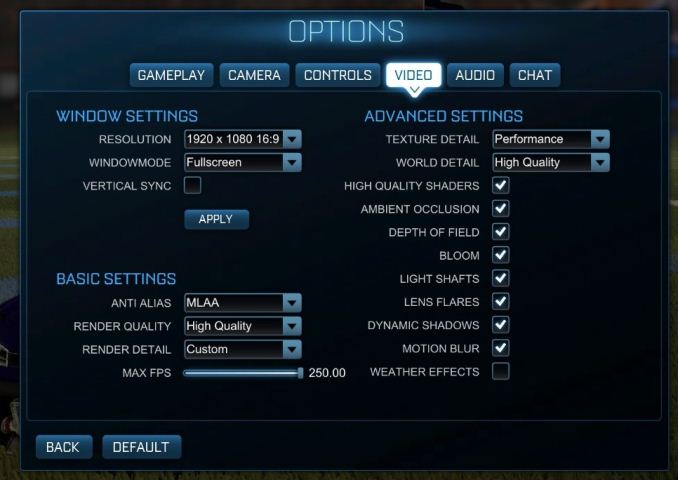Retesting AMD Ryzen Threadripper’s Game Mode: Halving Cores for More Performance
by Ian Cutress on August 17, 2017 12:01 PM ESTRocket League
Hilariously simple pick-up-and-play games are great fun. I'm a massive fan of the Katamari franchise for that reason — passing start on a controller and rolling around, picking up things to get bigger, is extremely simple. Until we get a PC version of Katamari that I can benchmark, we'll focus on Rocket League.
Rocket League combines the elements of pick-up-and-play, allowing users to jump into a game with other people (or bots) to play football with cars with zero rules. The title is built on Unreal Engine 3, which is somewhat old at this point, but it allows users to run the game on super-low-end systems while still taxing the big ones. Since the release in 2015, it has sold over 5 million copies and seems to be a fixture at LANs and game shows. Users who train get very serious, playing in teams and leagues with very few settings to configure, and everyone is on the same level. Rocket League is quickly becoming one of the favored titles for e-sports tournaments, especially when e-sports contests can be viewed directly from the game interface.
Based on these factors, plus the fact that it is an extremely fun title to load and play, we set out to find the best way to benchmark it. Unfortunately for the most part automatic benchmark modes for games are few and far between. Partly because of this, but also on the basis that it is built on the Unreal 3 engine, Rocket League does not have a benchmark mode. In this case, we have to develop a consistent run and record the frame rate.
Read our initial analysis on our Rocket League benchmark on low-end graphics here.
With Rocket League, there is no benchmark mode, so we have to perform a series of automated actions, similar to a racing game having a fixed number of laps. We take the following approach: Using Fraps to record the time taken to show each frame (and the overall frame rates), we use an automation tool to set up a consistent 4v4 bot match on easy, with the system applying a series of inputs throughout the run, such as switching camera angles and driving around.
It turns out that this method is nicely indicative of a real bot match, driving up walls, boosting and even putting in the odd assist, save and/or goal, as weird as that sounds for an automated set of commands. To maintain consistency, the commands we apply are not random but time-fixed, and we also keep the map the same (Aquadome, known to be a tough map for GPUs due to water/transparency) and the car customization constant. We start recording just after a match starts, and record for 4 minutes of game time (think 5 laps of a DIRT: Rally benchmark), with average frame rates, 99th percentile and frame times all provided.
The graphics settings for Rocket League come in four broad, generic settings: Low, Medium, High and High FXAA. There are advanced settings in place for shadows and details; however, for these tests, we keep to the generic settings. For both 1920x1080 and 4K resolutions, we test at the High preset with an unlimited frame cap.
All of our benchmark results can also be found in our benchmark engine, Bench.
MSI GTX 1080 Gaming 8G Performance

1080p



4K



Sapphire Nitro R9 Fury 4G Performance

1080p



4K



Sapphire Nitro RX 480 8G Performance

1080p



4K



With Ryzen, we encounted some odd performance issues when using NVIDIA-based video cards that caused those cards to significantly underperform. However equally strangely, the issues we have with Ryzen on Rocket League with NVIDIA GPUs seem to almost vanish when using Threadripper. Again, still no easy wins here as Intel seems to take Rocket League in its stride, but Game mode still helps the 1950X. The Time Under graphs give some cause for concern, with the 1950X consistently being at the bottom of that graph.












104 Comments
View All Comments
Aisalem - Thursday, August 17, 2017 - link
Ok, I'm a noob then, actually I'm an engineer who's doing designs in AutoCad, Creo and Solidworks but from time to time like to play few games.So yes I'm a NOOB who has some free cash to throw AMD direction and would like to know what are the best settings for it to play a game once or twice a week without spending hours on testing those.
Gigaplex - Thursday, August 17, 2017 - link
That makes you a workstation user, not a noob who buys Threadripper just for games.pepoluan - Friday, August 18, 2017 - link
Why do you want to change to Game Mode anyways? Is playing in Creator Mode not Good Enough for you?Ratman6161 - Friday, August 18, 2017 - link
Actually you sound more like the actual target audience for game mode. But for your purposes I would think you would want reviews with more heavy emphasis on workstation tasks. Gaming with it is just a sidelight.Greyscend - Saturday, August 19, 2017 - link
If you really are an engineer you shouldn't need hours to figure out if you can disable SMT while "Game Mode" is active. In fact, you shouldn't even need "hours" to turn on game mode and play a few minutes of your current, favorite game, then turn off SMT (if possible in game mode) and play again. I'm no engineer but I would have to be on Peyote and a bottle of wine to make all of this take longer than 30 minutes. Also, you may find that the bleeding edge isn't the best place for people who need to be told exactly how to configure their own machines.Ratman6161 - Friday, August 18, 2017 - link
Exactly"For the average person reading most of tech sites the more workstation benchmarks doesn't really makes sense."
Counter point: The "more workstation benchmarks" and the tasks they represent are the reason this CPU exists in the first place. If you want a Ryzen and gaming is your primary use, you would be better off with something in the R7 family since when you disable half the cores, you effectively have the equivalent of an 1800x.
The only reason game mode would exist is for someone who really needs to do those "more workstation" tasks for work purposes but also wants to to use the same machine for games when not doing actual work. IMO, the reviews should really stick even more to workstation use cases with gaming being an "oh, by the way, you can play games on it too" sort of deal.
Ian Cutress - Sunday, August 20, 2017 - link
https://myhacker.net | Hacking Tutorials | Hacking news | hacking tools | hacking ebooksGothmoth - Thursday, August 17, 2017 - link
waiting for anandtech praising the 8% on average performance boost of the 9000 intel cpu generation.... :-)peevee - Friday, August 18, 2017 - link
3%peevee - Friday, August 18, 2017 - link
Been this way for the last 5 generations. Moore's law is over.